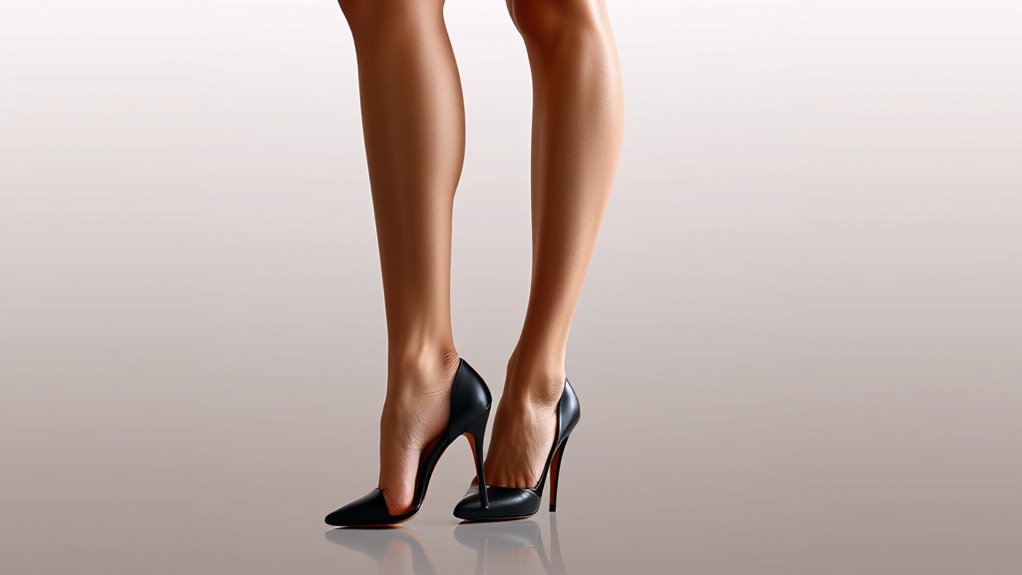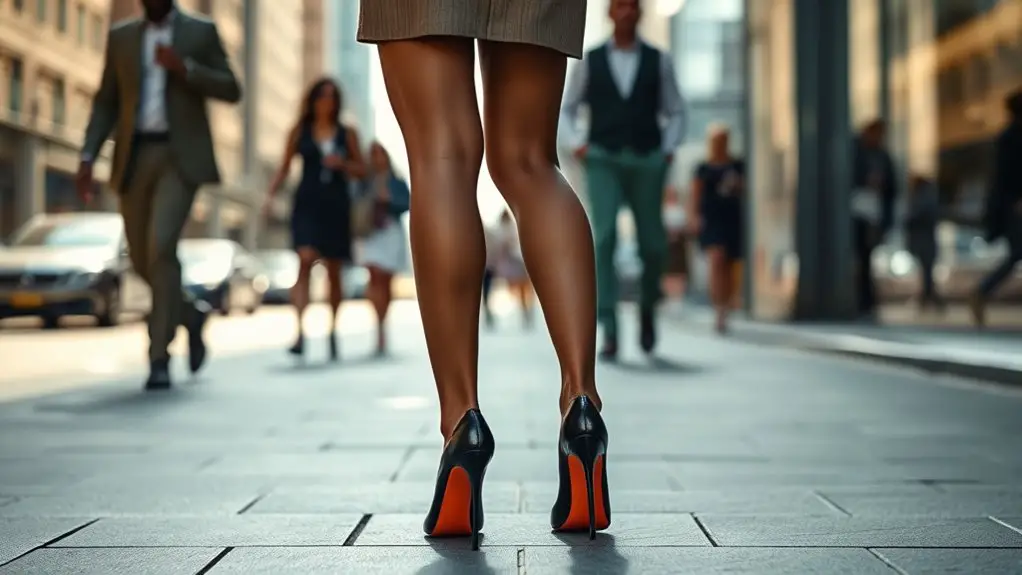Wearing heels can markedly change your body language by enhancing your posture and projecting confidence. The elevated height shifts your center of gravity, prompting you to stand taller and engage your core. This upright stance communicates authority and poise, altering how others perceive you in both social and professional settings. Additionally, your foot positioning sends nonverbal cues that can express openness or defensiveness. Discover how these effects intertwine with societal expectations and personal style.
The Science of Posture and Heels

When you slip on a pair of heels, you’re not just elevating your height; you’re fundamentally altering your posture and the way you carry yourself. The biomechanics of heels compel your body into a more upright position, shifting your center of gravity. This shift enhances your posture alignment, making you appear more confident and poised.
As your weight transfers to the balls of your feet, your spine straightens, and your shoulders naturally roll back. This change in stance doesn’t just affect your physical appearance; it also influences how others perceive you. The alignment created by heels signals authority and sophistication, which can enhance your body language in social and professional settings.
However, it’s essential to balance style with comfort. Prolonged wear can lead to discomfort or even long-term issues. Understanding heel biomechanics allows you to make more informed choices about your footwear, enhancing both style and well-being.
Height and Its Psychological Impact
Height carries a significant psychological impact that transcends mere measurement. Your height influences how others perceive you, which can have profound effects on your interactions. Height perception plays a vital role in social dynamics, often associating taller individuals with authority and confidence. This can lead to both advantages and disadvantages in various settings, from professional environments to personal relationships.
| Height Perception | Positive Psychological Effects | Negative Psychological Effects |
|---|---|---|
| Taller Individuals | Increased confidence | Heightened expectations |
| Shorter Individuals | Enhanced relatability | Potential for intimidation |
| Average Individuals | Balanced perception | Possible feelings of inadequacy |
Understanding these psychological effects is essential. By recognizing how height shapes interactions, you can navigate social situations more effectively, regardless of your stature. Height isn’t just a number; it’s a dynamic element of how you engage with the world.
The Confidence Boost From Elevated Footwear

When you slip on a pair of heels, you might notice an immediate shift in your posture and presence. Elevated footwear not only enhances your physical height but also transforms how others perceive you. This newfound stature can amplify your confidence, making you feel empowered in social and professional settings.
Posture and Presence
Although many may underestimate the impact of footwear on body language, wearing heels can greatly alter your posture and presence. When you slip on a pair of heels, you naturally engage your core and adjust your posture alignment, lifting your chest and elongating your spine. This shift not only enhances your physical appearance but also projects confidence and authority. As your center of gravity changes, your body instinctively finds a more poised stance, which contributes to a stronger presence enhancement in social or professional settings. People are likely to perceive you as more assertive and self-assured, leading to increased opportunities and positive interactions. So, the next time you choose your outfit, consider how those heels can transform your overall demeanor.
Visual Perception Shift
Wearing elevated footwear like heels can considerably shift how others perceive you, as the visual impact of your appearance often influences their judgments. When you slip on a pair of heels, it’s not just about height; it’s about the confidence that radiates from your body language. Elevated footwear subtly alters your posture, making you stand taller and appear more assertive. This shift in visual perception can lead people to view you as more competent and self-assured. As your body language transforms, so does the message you send; you exude an aura of confidence that others can’t help but notice. Therefore, the choice of heels isn’t merely aesthetic—it’s a powerful tool for enhancing how you’re perceived in any setting.
Nonverbal Cues: What Your Feet Say
Your feet aren’t just for walking; they silently communicate your confidence and presence. The way you position them can greatly influence how others perceive you, from elevated heels boosting your stature to your posture reflecting your inner state. By understanding these nonverbal cues, you can harness the power of your feet to enhance your overall impact in any situation.
Height and Confidence Boost
A significant number of studies suggest that height can influence perceived confidence, and the footwear you choose plays a crucial role in this dynamic. When you slip on a pair of heels, you not only gain a height advantage but also change how others perceive your confidence. Taller individuals often command more attention and respect, thanks to societal biases linking height with authority. By elevating your stature, you project an image of self-assuredness that can affect both your interactions and opportunities. This shift in confidence perception can be powerful; feeling taller often translates to bolder body language and assertive communication. Ultimately, the right footwear can catalyze a transformation, enhancing your presence and the way others respond to you.
Foot Position and Perception
Elevating your height with heels not only boosts your confidence but also influences how your body language is perceived, particularly through foot positioning. Your foot alignment can convey messages about your openness and approachability. For instance, if your feet are pointed toward someone, it signals interest and engagement, while crossed feet might suggest defensiveness or discomfort. Wearing heels often encourages a more intentional foot position, enhancing your body confidence. This subtle shift can affect others’ perceptions of you, often viewing you as more assertive and self-assured. So, by simply adjusting your foot placement in those stylish heels, you’re not just elevating your physical stature; you’re also sending powerful nonverbal cues that can shape interactions and impressions.
Posture and Presence Impact
While it might seem that posture is solely about back alignment, the impact of how you carry yourself—including your foot positioning—plays an essential role in nonverbal communication. Your posture alignment can reflect confidence, openness, or even insecurity. When you’re aware of your body, especially your feet, it shapes how others perceive you.
| Foot Position | Impact on Presence | Example Scenario |
|---|---|---|
| Feet Together | Closed, reserved | Speaking in a small group |
| Feet Apart | Open, confident | Presenting to an audience |
| One Foot Forward | Engaged, assertive | Networking at an event |
| Weight Shifted | Uncertain, distracted | In a high-pressure situation |
Enhancing body awareness can greatly elevate your nonverbal cues, creating a lasting impression.
Heels and Their Influence on Social Perception
When you slip on a pair of heels, you might not realize the profound impact they can have on how others perceive you. Heels symbolize confidence and femininity, reflecting societal expectations that often dictate fashion choices. This footwear trend influences gender dynamics, as women may feel empowered or restricted by their choice to wear heels. The cultural significance of heels extends beyond aesthetics; they can shape body image and self-expression, affecting how you carry yourself and how others interpret your presence.
In social settings, wearing heels can subtly signal authority or desirability, aligning with or challenging traditional views of femininity. By choosing heels, you engage in a complex dialogue about identity and societal norms, where your footwear becomes a statement of personal style and cultural position. So, next time you put on those heels, consider the layers of meaning they convey and the social perceptions they may evoke.
The Connection Between Footwear and Femininity

When you slip on a pair of heels, you’re not just changing your height; you’re also altering your posture and the way you carry yourself. This footwear can enhance your sense of femininity and boost your confidence, making you more aware of how others perceive you. As you navigate social spaces, the connection between your shoes and your self-presentation becomes strikingly clear.
Heels and Confidence Boost
Confidence often emerges from the choices we make, and for many women, slipping into a pair of heels can spark a profound transformation. This isn’t just about aesthetics; it’s rooted in heel psychology. When you wear heels, you often feel taller, which can naturally elevate your confidence levels. This shift in posture and presence can turn your confidence attire into a powerful statement. Heels can enhance your femininity, allowing you to embrace a more assertive version of yourself. As you walk with purpose, you embody strength and poise, inviting others to perceive you differently. Ultimately, the right pair of heels can serve as a tool for empowerment, creating a direct link between your footwear choices and your self-assurance.
Feminine Posture Enhancement
Although many factors contribute to how we carry ourselves, the choice of footwear plays a pivotal role in enhancing feminine posture. When you slip into a pair of heels, you naturally adjust your stance, promoting better posture alignment. This shift not only elongates your legs but also encourages an upright position that radiates feminine grace. Your body instinctively adapts, leading to a more confident and poised demeanor. The arch of a heel engages your core muscles, further supporting an elegant posture. By choosing the right footwear, you’re not just altering your height; you’re transforming how you present yourself to the world. This subtle yet powerful connection between heels and posture can enhance your overall sense of femininity and self-assuredness.
Social Perceptions of Femininity
As society increasingly emphasizes visual impressions, the choice of footwear becomes a powerful symbol of femininity. When you slip on a pair of heels, you’re not just enhancing your stature; you’re embodying feminine ideals that society often dictates. These ideals reflect societal expectations, suggesting that femininity is tied to grace, poise, and allure. By choosing heels, you may align yourself with these perceptions, consciously or unconsciously communicating your adherence to traditional femininity. Yet, this connection can be a double-edged sword. While heels can empower some, they may also reinforce restrictive norms. Ultimately, your footwear choices can influence how others perceive your femininity, revealing the complex relationship between fashion, identity, and societal pressures in today’s world.
How Heels Alter Your Walking Style
When you slip on a pair of heels, your entire gait transforms, reflecting not just a change in footwear but an evolution in body mechanics. The heel height forces your body to adjust its posture, shifting your weight forward and encouraging a more upright stance. This shift alters your walking rhythm, making each step more deliberate and pronounced. You’ll notice how your hips sway slightly, enhancing your femininity and confidence in movement.
As you walk, the click of your heels on the ground creates an auditory cue that can command attention and signal authority. The change in balance requires you to engage your core more actively, which not only improves stability but also projects self-assurance. Ultimately, wearing heels can redefine how you move through space, subtly influencing how others perceive you—an intricate interplay of biomechanics and body language that’s hard to ignore.
The Role of Heels in Professional Settings
Wearing heels in professional settings can greatly enhance the way you’re perceived in the workplace. The footwear impact of heels often translates to an elevated presence, subtly shifting workplace dynamics in your favor. When you choose heels as part of your professional attire, you’re not just making a style choice; you’re also influencing how colleagues and clients perceive your confidence.
Research shows that body language plays a critical role in social interactions, and the added height from heels can amplify your assertiveness. This elevated stature may lead others to regard you as more authoritative, enhancing your credibility in meetings and discussions.
Moreover, wearing heels can boost your confidence perception, allowing you to navigate professional environments with poise. Ultimately, the right footwear can serve as a powerful tool in shaping not just your style, but also the way you engage with those around you, making a lasting impression.
Cultural Perspectives on Heels and Body Language
While heels are often seen as a symbol of femininity and sophistication in many cultures, their significance extends far beyond mere aesthetics. You might not realize how deeply intertwined heels are with cultural significance and societal norms. In some societies, they convey status and authority, while in others, they represent the pressure to conform.
| Cultural Context | Perception of Heels |
|---|---|
| Western Cultures | Empowerment and elegance |
| Asian Cultures | Tradition and beauty standards |
| Middle Eastern Cultures | Symbol of femininity and allure |
These varying perspectives shape how you carry yourself while wearing heels, influencing your body language. When you slip into a pair, you may feel empowered or self-conscious, reflecting broader cultural narratives. Understanding this can help you navigate your own experience with heels and their impact on your presence in different settings.
Finding Balance: Comfort vs. Style in Heels
Steering through the world of heels often presents a dilemma between comfort and style, a balancing act that many face. When you step out in heels, you want to exude confidence and elegance, yet those style choices can come with significant comfort factors. It’s vital to take into account not only how a pair of shoes looks but also how they feel.
Investing in heels that combine both aesthetics and comfort isn’t just smart; it’s essential for the longevity of your feet and your overall well-being. Look for designs that offer adequate arch support and cushioning. Remember, a stylish appearance can quickly lose its allure if you’re wincing with every step. Ultimately, finding that sweet spot between comfort and style empowers you to walk with confidence and grace, enhancing your body language and leaving a lasting impression. So, don’t sacrifice comfort for style; aim for harmony in your footwear choices.
Frequently Asked Questions
Can Wearing Heels Lead to Long-Term Health Issues?
Wearing heels can lead to long-term health issues, like altered foot structure and joint pain. These factors may cause discomfort and limit mobility, so it’s essential to contemplate the potential risks before regularly choosing heels.
How Do Heels Affect Balance and Stability?
Did you know that 72% of women report balance issues in heels? The heel design alters your foot biomechanics, making stability challenging. This can lead to increased risk of falls and long-term musculoskeletal problems.
Are Certain Heel Heights Better for Body Language?
Certain heel heights can enhance your body language by improving posture. Higher heels often lead to better posture improvement, projecting confidence. However, too much height may compromise stability, so balance heel height effects carefully for ideal communication.
Can Heel Choice Influence Social Interactions?
Your heel choice can greatly influence social interactions. When you wear heels, it boosts your confidence, altering social perception. This confidence can lead to more positive engagements, making you appear more approachable and assertive in various situations.
Do Men’S Heels Have the Same Impact on Body Language?
Men’s heels can indeed influence body language. They often enhance masculine confidence and alter height perception, making you appear more authoritative. This shift can markedly affect how others perceive and interact with you socially.



